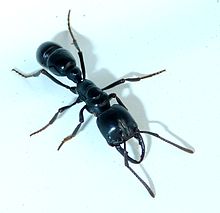| Plectroctena mandibularis | |
|---|---|
 | |
| Plectroctena mandibularis worker | |
| Scientific classification | |
| Domain: | Eukaryota |
| Kingdom: | Animalia |
| Phylum: | Arthropoda |
| Class: | Insecta |
| Order: | Hymenoptera |
| Family: | Formicidae |
| Genus: | Plectroctena |
| Species: | P. mandibularis |
| Binomial name | |
| Plectroctena mandibularis F.Smith, 1858 | |
| Synonyms | |
| |
Plectroctena mandibularis, called the ringbum ant or millipede munching ant, [1] [2] [3] is a large species of ant that ranges from the Eastern Cape, South Africa, through East Africa to Ethiopia. Their workers forage singly [4] in open terrain, and their colony size seldom exceeds fifty individuals. [4] [5] It is one of the large Plectroctena species, including P. conjugata and P. minor , that specialize on adult millipedes as prey. [5] The nest is composed of chambers that are typically located two feet or more below the surface, and the nest entrances are usually marked by large piles of earth. [4] [5] They get their colloquial, common name from their tendency to prey on millipedes.